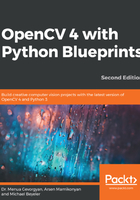
Finding connected components in a segmentation mask
We already know that the center region belongs to the hand. For such a scenario, we can simply apply cv2.floodfill to find all the connected image regions.
Before we do this, we want to be absolutely certain that the seed point for the flood fill belongs to the right mask region. This can be achieved by assigning a grayscale value of 128 to the seed point. However, we also want to make sure that the center pixel does not, by any coincidence, lie within a cavity that the morphological operation failed to close.
So, let's set a small 7 x 7-pixel region with a grayscale value of 128 instead, like this:
small_kernel = 3
frame[height // 2 - small_kernel:height // 2 + small_kernel,
width // 2 - small_kernel:width // 2 + small_kernel] = 128
As flood filling (as well as morphological operations) is potentially dangerous, OpenCV requires the specification of a mask that avoids flooding the entire image. This mask has to be 2 pixels wider and taller than the original image and has to be used in combination with the cv2.FLOODFILL_MASK_ONLY flag.
It can be very helpful to constrain the flood filling to a small region of the image or a specific contour so that we need not connect two neighboring regions that should never have been connected in the first place. It's better to be safe than sorry, right?
Nevertheless, today, we feel courageous! Let's make the mask entirely black, like this:
mask = np.zeros((height + 2, width + 2), np.uint8)
Then, we can apply the flood fill to the center pixel (the seed point), and paint all the connected regions white, as follows:
flood = frame.copy()
cv2.floodFill(flood, mask, (width // 2, height // 2), 255,
flags=4 | (255 << 8))
At this point, it should be clear why we decided to start with a gray mask earlier. We now have a mask that contains white regions (arm and hand), gray regions (neither arm nor hand, but other things in the same depth plane), and black regions (all others). With this setup, it is easy to apply a simple binary threshold to highlight only the relevant regions of the pre-segmented depth plane, as follows:
ret, flooded = cv2.threshold(flood, 129, 255, cv2.THRESH_BINARY)
This is what the resulting mask looks like:

The resulting segmentation mask can now be returned to the recognize function, where it will be used as an input to the find_hull_defects function, as well as a canvas for drawing the final output image (img_draw). The function analyzes the shape of a hand in order to detect the defects of a hull that corresponds to the hand. Let's learn how to perform hand shape analysis in the next section.